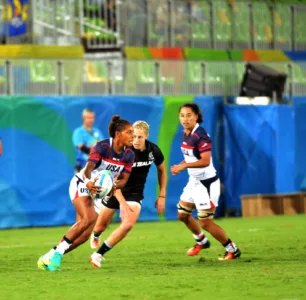Rugby, a sport renowned for its blend of power, strategy, and teamwork, constantly evolves as players and teams search for innovative ways to outwit their opponents. One such technique that has gained prominence in recent years is the kick-pass. This strategic maneuver involves seamlessly combining kicking and passing to launch a dynamic attacking play. In this extensive guide, we delve into the nuances of using the kick-pass as an effective tool in rugby, uncovering its tactical advantages, skills required, and real-game examples.
The Art of the Kick-Pass
Understanding the Kick-Pass
The kick-pass, as the name suggests, merges two essential skills – kicking and passing. It entails a player executing a precisely timed kick, followed by a swift pass to a teammate who is strategically positioned to receive the ball. This technique is particularly advantageous when a direct pass might be intercepted or when exploiting gaps in the opponent’s defensive line.
Tactical Advantages
1. Element of Surprise
Defenses in rugby are often organized to counter conventional running and passing plays. When a kick-pass is introduced, it introduces an element of surprise that catches the opposing team off-guard. Defenders might be positioned to anticipate a direct pass or a running play, leaving open spaces on the opposite side of the field. A well-executed kick-pass takes advantage of this surprise factor, allowing the attacking team to exploit the openings in the defense.
2. Gaining Territory
One of the primary benefits of a kick-pass is its ability to gain significant territory on the field. By accurately placing the ball in an unoccupied area of the field, the attacking team can bypass clusters of defenders and move closer to the opponent’s try line. This territorial gain can put immense pressure on the defense and provide the attacking team with a favorable field position from which to launch further attacks.
3. Bypassing Defenders
In rugby, defenders often rush up quickly to close down space and put pressure on the ball carrier. This defensive strategy can create gaps and vulnerabilities in the defensive line. A well-timed kick-pass allows the attacking team to bypass these rushing defenders, as the ball is lofted over them to a waiting teammate. This creates a numerical advantage for the attacking team and forces the defenders to backtrack quickly, giving the attacking side precious seconds to exploit the disarray in the defense.
4. Creating Try-Scoring Opportunities
A accurately placed kick-pass can create immediate try-scoring opportunities. If the receiving player is able to gather the ball cleanly and is in a good attacking position, they can potentially breach the defensive line or find themselves in a one-on-one situation with the last defender. This can lead to breakaway runs or well-positioned passes to supporting players, greatly increasing the chances of scoring a try.
5. Tactical Variation
Rugby is a sport that thrives on unpredictability. Repeatedly using the same attacking strategies can make a team’s playstyle predictable and easier to defend against. Incorporating kick-passes into the playbook adds a layer of variation that keeps the defense guessing. This variation in playstyle makes it challenging for defenders to anticipate the next move, giving the attacking team a competitive edge.
6. Counteracting Rushing Defenses
When a defensive team employs a rushing or blitzing strategy, where defenders aggressively charge forward to disrupt the attacking team’s play, a kick-pass can be a potent countermeasure. By launching a well-timed kick-pass over the rushing defenders, the attacking team can exploit the spaces left vacant by the charging players. This can lead to breakaway opportunities and sudden shifts in momentum.
7. Exploiting Mismatches
Rugby often sees mismatches in terms of size, speed, and positioning between players. A kick-pass can be used strategically to exploit these mismatches. For example, if a smaller, faster player is matched up against a larger, slower opponent, a kick-pass can be directed to the area where the smaller player is positioned, allowing them to use their speed to their advantage and potentially gain a significant advantage.
Practical Tips for Implementing the Kick-Pass
1. Read the Defense
Analyzing the opponent’s defensive formation is crucial. Identify gaps or areas where the defensive line might be weaker, increasing the chances of a successful kick-pass play.
2. Practice Under Pressure
Simulate game scenarios during practice sessions. Practice executing kick-passes while under pressure from defenders to refine decision-making and kicking accuracy.
3. Variety is Key
Don’t limit yourself to a single type of kick-pass. Develop proficiency in various kicking techniques to keep the defense guessing.
4. Trust and Chemistry
Building trust and chemistry with your teammates is paramount. Understand their playing styles, running lines, and preferences to ensure seamless coordination during a kick-pass play.
5. Adaptability
Like any strategy, the kick-pass requires adaptability. If the defense catches on, be ready to switch tactics and exploit their adjustments.
Incorporating the Kick-Pass into Training Drills
1. Kick-Pass Relay Drill
Set up a relay race where players alternate between executing kicks and receiving passes. This drill hones both kicking accuracy and coordination between players.
2. Defensive Press Drill
Create a defensive line, and task the attacking team with breaking through using kick-pass plays. This drill enhances decision-making under defensive pressure.
3. Cross-Kick Accuracy Drill
Focus on the cross-kick by placing targets on opposite ends of the field. Players must accurately kick to their teammates positioned as targets.
Conclusion
The kick-pass is a versatile weapon in rugby’s arsenal, capable of disorienting defenses and propelling the attacking team to victory. By mastering the art of the kick-pass, players can add a new dimension to their gameplay, making them a force to be reckoned with on the field. This guide has illuminated the tactical advantages, essential skills, real-game examples, and practical tips that define this dynamic technique. As you step onto the rugby field, armed with the knowledge from this guide, remember that the kick-pass is not just a play – it’s a game-changer.

